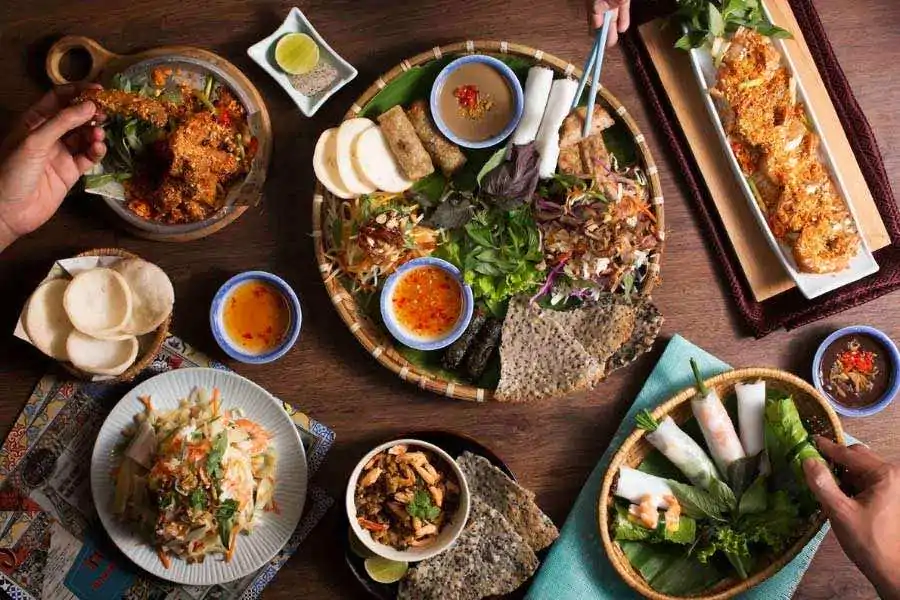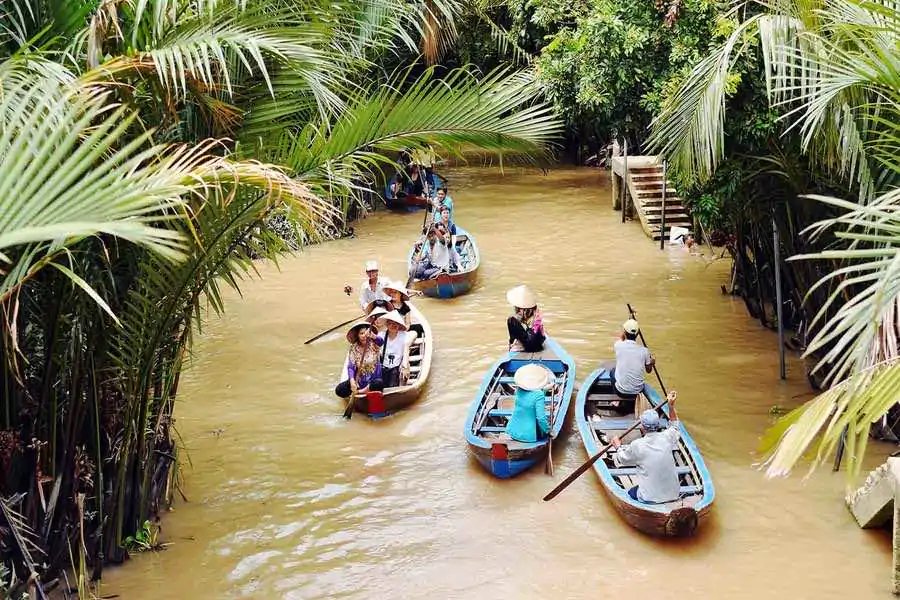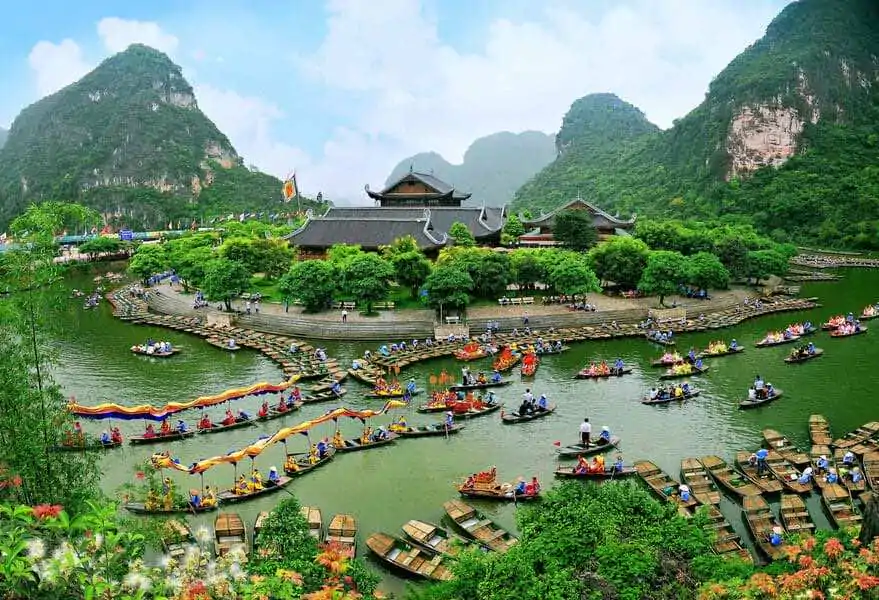Vietnam is quickly becoming one of the most popular travel destinations for Australians looking for an exotic and adventurous vacation in Southeast Asia. Known for its breathtaking natural scenery, mouthwatering cuisine, fascinating history, and vibrant culture, Vietnam has something to offer every type of traveler. From the lively cities of Hanoi and Ho Chi Minh to the serene beaches of Nha Trang, to the majestic peaks of Sapa and sprawling rice paddies and floating markets of the Mekong Delta, Vietnam packs a punch for such a skinny country! This comprehensive guide will provide everything you need to know to plan the perfect tour to Vietnam from Australia.
When is the Best Time to Visit Vietnam?
Vietnam has a tropical monsoon climate which means the weather varies quite a bit throughout the year. The optimum time to visit is generally agreed to be between November – April, during the dry season when temperatures are comfortable and rainfall is minimal. The hottest months are May to September, which coincide with the summer monsoon bringing very hot, humid and wet weather. September – October is shoulder season with occasional showers. Overall the north experiences cooler temperatures than the south. Peak season is between November to March when prices are highest and crowds at their largest, so for a balance of good weather and smaller crowds, April – May or September – October are great options.
How Long Should I Stay in Vietnam?
Most travelers spend 2-3 weeks exploring Vietnam which allows enough time to see the highlights at a comfortable pace. With only 10-14 days you could squeeze in the main attractions but it will feel quite rushed. If you have more time, 4 weeks would allow for a more immersive experience with time to venture off the beaten path. The major destinations like Hanoi, Halong Bay, Hoi An and Ho Chi Minh City warrant 3-4 days each, while more remote regions like Sapa could take a full week when factoring in travel time. Taking an overnight cruise in Halong Bay and a train ride is also highly recommended.
What is the Budget for a Vietnam Tour?
Vietnam is very budget-friendly, especially compared to most Western countries. You can comfortably travel for around $50 USD a day per person if you stay in budget accommodation, eat street food, and use local transportation. Mid-range expect to spend $75-$100 per day, and luxury could run over $200 per day. Other costs to factor in are domestic flights ($50-110 each), activity fees like entrance tickets ($1.5-50 per site), and any organized tour fees which vary widely. E-visas cost around $25. In total, plan to budget $1000 per person minimum for 2 weeks, excluding international flights.
Do I Need a Visa for Vietnam?
Yes, Australians need to obtain a visa before traveling to Vietnam. There are two options – an E-visa can be applied for online prior to your trip which takes 3-5 working days to process and is valid for 30 days single entry. Or you can get a visa on arrival by applying via an agent and paying an additional fee, which allows multiple entries and longer stays. The visa on arrival is stamped into your passport at the airport upon landing in Vietnam. The process is relatively quick and painless.
How to Get to Vietnam from Australia?
There are no direct flights from Australia to Vietnam. Most major airlines like Qantas, Vietnam Airlines and Cathay Pacific offer flights from Sydney, Melbourne and Brisbane which connect through Asian hubs like Singapore, Kuala Lumpur, Hong Kong or Bangkok. Average flight times are around 10 hours including layovers. Jetstar, Scoot and AirAsia offer cheaper budget flights with more stops. Departing from Darwin or Perth tacks on an extra 1-2 hours of travel time. Shop around for deals, but aim for $600-800 return flights if traveling in peak season.
Top Destinations and Attractions in Vietnam
Hanoi
The capital of Vietnam and a must-visit for its French colonial architecture, countless temples and pagodas, vibrant street life and mouthwatering cuisine. Top attractions include the Old Quarter, Hoan Kiem Lake, Ho Chi Minh Mausoleum Complex, the Temple of Literature and Thang Long Water Puppet Theatre. Take a walking, cycling or food tour to dive into Hanoi’s chaotic charm.
Halong Bay
This UNESCO World Heritage Site with over 3000 limestone islands rising from the emerald waters of the Gulf of Tonkin is breathtaking. Take an overnight cruise to experience the bay’s natural beauty and floating villages. Kayaking, swimming, hiking and Tai Chi on deck are popular activities.
Hoi An
On the central coast, this beautifully preserved ancient town enchants visitors with rows of traditional shophouses, colorful lanterns, temples, tailors, and cuisine. Wander the streets, get custom-made clothes custom made, and visit nearby beaches and ruins.
Ho Chi Minh City
The largest and most modern city in Vietnam, locals still call it Saigon. Check out French colonial landmarks like Notre Dame Cathedral and the Central Post Office, war history at the Cu Chi Tunnels and Reunification Palace, and the buzzing Ben Thanh Market.
Mekong Delta
The ‘rice bowl’ of Vietnam with lush green rice paddies, tropical fruit orchards, local villages and floating markets, best explored on a river cruise. Don’t miss the unique vélo Food Tour to sample regional delicacies.
Sapa
In northern Vietnam near the Chinese border, Sapa is famous for epic scenery of terraced rice fields carved into mountainsides and home to hill tribes. Hiking and trekking through remote minority villages is a top activity.
Phong Nha-Ke Bang National Park
This UNESCO World Heritage Site contains the oldest karst mountains in Asia and hundreds of caves including Son Doong, the world’s largest. Adventure seekers can explore cave systems with underground rivers, dramatic stalagmites and more.
10-Day Vietnam Sample Tour from South to North
Day 1 – Arrive Ho Chi Minh City
- Arrive and check into hotel
Day 2 – Ho Chi Minh City
- Cu Chi Tunnels day trip
- Explore city landmarks like War Museum, Notre Dame Cathedral, Central Post Office
- Shopping at Ben Thanh Market
Day 3 – Mekong Delta Day Trip
- Boat cruise through floating markets, villages of Mekong
- Sample local fruits and cuisine
Day 4 – Fly to Danang, Transfer to Hoi An
- Flight to Danang, transfer to Hoi An
- Wander around charming Ancient Town
Day 5 – Hoi An Ancient Town
- Visit old houses, Japanese Bridge, museums
- Get custom clothes made
Day 6 – Hue Day Trip – Evening Flight to Hanoi/or Overnight Train to Hanoi
- Transfer to Hue to visit Imperial City, royal tombs and pagodas
- Evening flight to Hanoi or take overnight train to Hanoi, arrival in the early morning of the next day
Day 7 – Hanoi City Tour
- Morning flight to Hanoi. Visit Temple of Literature, One Pillar Pagoda
- Walk around Hoan Kiem Lake area. Embark on a cyclo tour of Hanoi’s Old Quarter
Day 8 – Hanoi Halong Bay Cruise
- Off to Halong Bay for overnight cruise and stay overnight on the cruise boat
- Cruise through stunning Halong Bay
Day 9 – Halong Bay Cruise – Hanoi
- Kayak, swim, explore caves if time allows
- Return to Hanoi
Day 10 – Fly Home from Hanoi
- Free morning in Hanoi
- Afternoon flight back home
Tips for Booking Accommodation
Vietnam offers a wide range of accommodations from hostels to luxury resorts.
- Budget hotels generally run $30-$35 per night for simple rooms with air-con and ensuite bathrooms.
- Mid-range hotels from $35-$70 per night come with extra amenities like pools, restaurants and fitness centers.
- Luxury and boutique hotels start upwards of $100 per night for five-star service and facilities.
- Beach destinations often have beachfront bungalows.
- Book at least a few weeks in advance for the best rates during peak season.
- Read reviews and check locations when choosing accommodations.
Don’t Miss These Iconic Vietnamese Foods and Drinks
- Pho – Fragrant beef and rice noodle soup, the national dish.
- Banh mi – Baguette stuffed with meats, herbs, and vegetables.
- Bun cha – Grilled pork with rice vermicelli noodles and dipping sauce.
- Banh xeo – Crispy Vietnamese crepes with pork, shrimp, and bean sprouts.
- Cao lau – Noodles mixed with pork, greens, and croutons, unique to Hoi An.
- Vietnamese coffee – Dark, strong coffee sweetened with condensed milk.
- Bia hoi – Fresh draught beer for less than 50 cents a glass.
- Nuoc mam – The quintessential fish sauce seasoning.
- Fruits – Mangoes, dragonfruit, jackfruit, rambutans and more!
Street food stalls are ubiquitous in cities like Hanoi and Ho Chi Minh and provide an authentic way to sample cheap, delicious local eats. Sign up for a street food tour to safely discover the best-hidden spots.
Getting Around Vietnam
- Flights: Vietnam Airlines and budget airlines like VietJet connect major cities like Hanoi, Danang, and Ho Chi Minh City.
- Trains: Efficient way to travel between main hubs along the country, with berths to sleep in for overnight journeys. Book early for routes like Hanoi to Sapa.
- Buses: A reliable, affordable bus network connects most destinations, though road conditions vary.
- Private cars: Hire a car and driver to customize an itinerary.
- Taxis: Widely available, metered taxis are best arranged via apps like Grab.
- Motorbike taxis: Fun local way to zip around cities, but not for the fainthearted!
- Cyclos: Cycle rickshaws allow leisurely exploration of smaller towns like Hoi An.
- Boats: Rivers like the Mekong Delta are best seen via boat tours.
Staying Safe and Healthy in Vietnam
- No vaccines are mandatory but hepatitis A, typhoid and rabies shots are recommended.
- Always drink bottled water and avoid ice in drinks.
- Only eat cooked, peeled fruits and vegetables and cooked meat.
- Bring hand sanitizer and use it frequently when out, especially before meals.
- Vietnam is very safe but normal travel precautions apply: Don’t carry large sums of money or display valuables, be cautious of scams and pickpockets in crowded places.
- Get comprehensive travel insurance. Medical facilities may require payment upfront.
- Register your trip with SmartTraveller before departing Australia.
- Wear high-SPF sunscreen and stay hydrated – the tropical sun is intense.
What to Pack for Vietnam
- Light, breathable clothing – think moisture-wicking fabrics, skirts and dresses. Don’t flash shoulders or knees at religious sites.
- Sturdy walking shoes for city exploring and hiking.
- Rain jacket or compact umbrella during rainy season.
- Swimsuit if partaking in beach time.
- Universal adapter for electronics.
- Photocopies of passport, visa, travel insurance – keep separately from originals.
- Prescription medications in original containers.
- Mosquito repellent with DEET.
- Light towel and antibacterial soap, many bathrooms don’t provide.
- Daypack for carrying essentials while sightseeing.
- Cash in Vietnamese Dong – have small bills for street vendors
Start Planning Your Dream Trip to Vietnam with Absolute Asia Travel!
Vietnam is an incredibly diverse, vibrant and fascinating country that finds a place in every traveler’s heart. With its rich cultural heritage, mouthwatering cuisine and jaw-dropping landscapes there is something for everyone. Follow this guide to craft your perfect multi-stop Vietnam tour full of life’s little adventures. Just don’t be surprised if you start planning your return trip before you’ve even departed – Vietnam has a way of drawing you back! Contact the Absolute Asia Travel team today to start planning your dream Vietnam tour.
 Editor team
Editor team September 28, 2023
September 28, 2023 Suggested Itineraries
Suggested Itineraries
 1135
1135 YOU MAY ALSO LIKE
YOU MAY ALSO LIKE
 read more
read more
